It is becoming more and more difficult to protect your privacy on your Android devices. Your privacy is being compromised by various apps. The Google privacy settings allows you to control the privacy of your Android data and device with a few simple settings. Double your security access with two-factor authentication. Some malicious apps will use your camera or microphone to record personal information about you without you knowing. Control which apps can use your camera, microphone and/or location.
Google Privacy Settings will Restrict and better control your privacy
The detailed instruction listed here may vary depending your version of Android. The procedures discussed here are applicable for Android 12 and Android 13. These procedures allows you to control which apps can use critical functions that may violate your privacy. Even though Google Play store scans each app to assure privacy can be controlled, you never know when an app will violate procedure.
1. Enable Two-factor authentication (2FA) to improve your privacy settings
- With 2FA, you have a second method to access your Google account, which, in turn, grants access to your Android devices. Passwords can be breached, but 2FA will prevent access due to breached passwords. The 2FA is a temporary access method that is good for a single use. Hackers cannot encroach the 2FA security method.
- To enable 2FA, on your Android device, do the following:
- Open Settings
- Open Google Services
- Touch on Manage your Google Account
- Scroll the tabs horizontally and touch on Security
- Scroll down and touch on 2-Step verification
Control Privacy Settings on Android – Limit App Permissions, App Accesses, Locations, and Ads
2. Control the permissions granted to each app.
(Manage App Permissions on Android Devices)
3. Manage which apps can use your locations.
(Which Apps Use Location Services?)
4. Disable personalized Ads that show on your Android device.
- Open your internet browser and enter Ad Settings
- Choose where you want the change to apply:
- On all devices where you’re signed in
- On your current device or browser
- Turn off Ad Personalization
- Once you have turned off ad personalization, Google will no longer use your personal information to decide which ads to display.
5. Disable camera and microphone access
How can you know when an app is using your camera or microphone?
- If an app is using your camera or microphone, a green dot indicator will show at the top right corner of your screen.
- Swipe down and tap on the indicator.
- Tap once to check which app or service is using your camera or microphone.
- Tap again to manage permissions.
Control which apps can use your camera and/or microphone
- Open Settings and touch to open Security and Privacy.
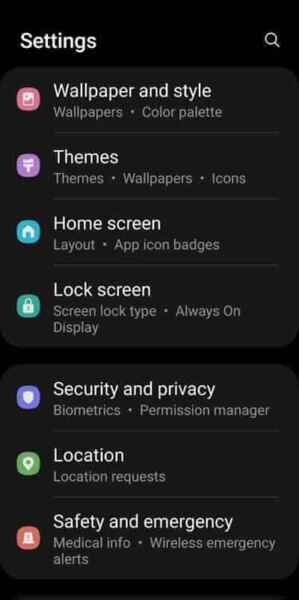
- Touch to open Privacy
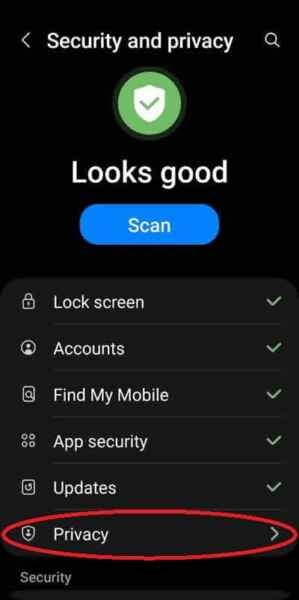
- Touch to open Permission manager
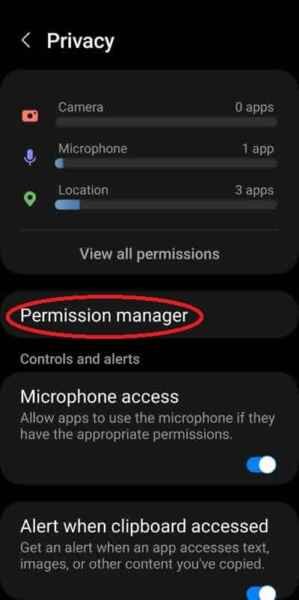
- Scroll through the list of Apps looking for Camera, Location and Microphone
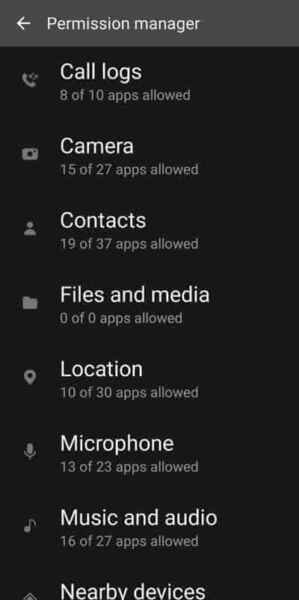
- You can open each one individually to see which apps are using the permission. For example, if you touch to open Camera, you will see which apps are Allowed All the Time, Allowed only when in use.
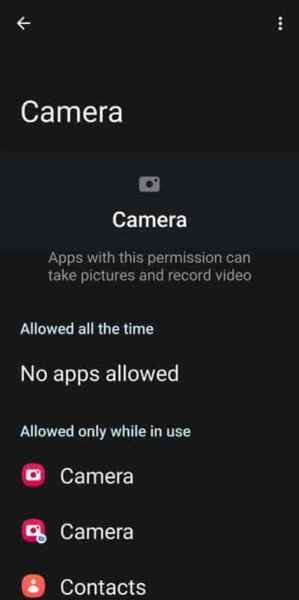
- Touch to open one of the apps, for example, Touch on Facebook to see how that app can use the camera
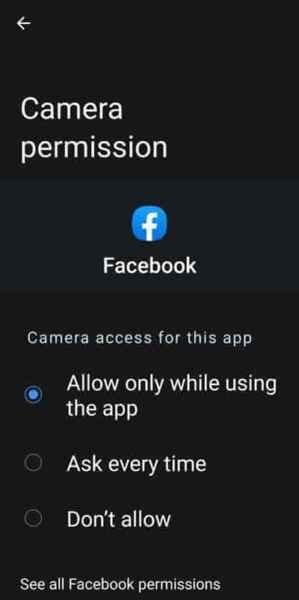
- You have three options of how the app can use the camera:
- Allow only while using the app
- Ask every time
- Don’t allow
- If you want to see all the permissions used by Facebook, Touch See all Facebook permissions.
- You can manage the permissions for the microphone and location using the same process for each app.
Basic Security Tips to Improve Privacy Settings on Android
Master Your Lock Screen:

- Set a strong password, PIN, or pattern for your lock screen. Avoid using easily guessable information like birthdays or anniversaries.
- Consider using biometric authentication like fingerprint or facial recognition for added security.
- Be sure the Find My Device settings are enable in case you miss-place your Android phone or tablet.
- Enable “Require PIN after restart” to prevent unauthorized access if your phone restarts unexpectedly.
- Adjust the lock screen timeout to a shorter duration.
- Guide to setting up and customizing the Lock Screen on your Android phone.
Secure Your Network Connections:
- Enable a VPN when using public Wi-Fi networks, especially for sensitive tasks like online banking or shopping.
- Avoid using automatic Wi-Fi connections and only connect to secure networks.
- Disable Bluetooth when not in use to prevent unauthorized connections.
Common Problems and Solutions for Improving Google Privacy Settings on Android
Despite Google’s efforts to offer customizable privacy settings, users often face challenges in understanding and managing them effectively. Here are some common problems and solutions:
- Information Overload:
Problem: The sheer number of Google privacy settings can be overwhelming, making it difficult to know where to begin and what options to prioritize.
Solutions:
- Start with the basics: Focus on key settings like ad personalization, location history, and app permissions.
- Use Google’s Privacy Checkup: This tool provides a personalized overview of your privacy settings and offers suggestions for improvement.
- Consult online resources: Websites and blogs offer guides and explanations for specific Google privacy settings.
- Difficulty Understanding Settings:
Problem: Some Google privacy settings use technical jargon or ambiguous language, making it difficult to understand their implications.
Solutions:
- Look for tooltips and explanations: Google often provides brief explanations for each setting, though they may not be exhaustive.
- Use online resources: Many websites offer plain-language explanations of Google privacy settings.
- Contact Google support: If you’re still unsure about a particular setting, contact Google support for assistance.
- Lack of Granular Control:
Problem: Some settings offer limited options for controlling your privacy. For example, you may only be able to turn a feature on or off entirely, without finer-grained control.
Solutions:
- Consider alternative services: If you’re uncomfortable with the level of control offered by Google, consider using alternative services with better privacy practices.
- Use privacy-enhancing tools: Browser extensions like Privacy Badger or DuckDuckGo Privacy Essentials can block tracking scripts and enhance your privacy.
- Voice your concerns: Let Google know you desire more granular control over your privacy settings. You can do this through their feedback channels or online forums.
- Settings Reverting or Resetting:
Problem: Sometimes Google privacy settings may revert back to their default state after updates or other changes.
Solutions:
- Regularly review your settings: Make it a habit to periodically revisit your privacy settings to ensure they haven’t changed.
- Enable automatic backups: Google offers a feature to automatically back up your privacy settings. This can help you restore them in case they are accidentally changed.
- Use a third-party tool: Some third-party tools can help you manage and monitor your Google privacy settings.
- Difficulty Opting out of Data Collection:
Problem: While Google offers ways to opt out of certain data collection practices, the process can be complex or require multiple steps.
Solutions:
- Utilize Google’s opt-out tools: Google provides tools like My Activity and Ads Settings to manage and control your data collection preferences.
- Use privacy-focused tools: Several extensions and apps can help you opt out of data collection across various websites and services.
- Be mindful of app permissions: Pay close attention to the permissions requested by apps and only grant access to what they absolutely need.
Additional Tips:
- Stay informed: Keep yourself updated about Google’s privacy policies and practices.
- Be vigilant: Be cautious about the information you share online and be aware of potential privacy risks.
- Take action: Don’t be afraid to adjust your settings and experiment with different privacy configurations.
By understanding these common problems and solutions, you can take control of your Google privacy settings and manage your data more effectively. Remember, privacy is an ongoing process, and it requires continuous vigilance and effort to maintain.
Protect your Android devices used in your business – The Best Android MDM Software: Features & Benefits
Solutions for 20 common mistakes on Android – 20 Common Android Mistakes and How to Fix Them




